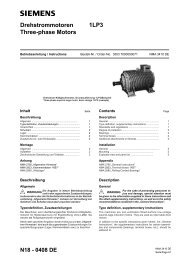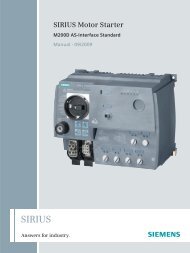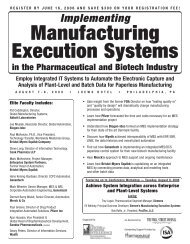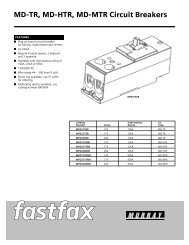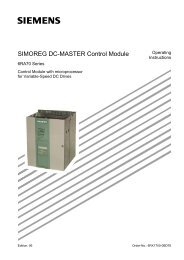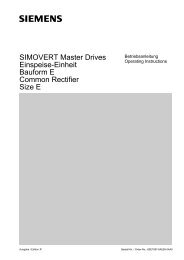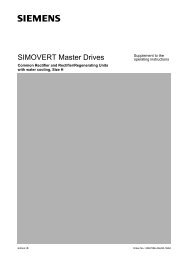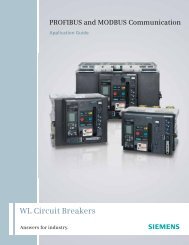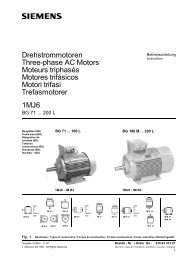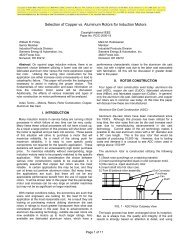Cementing the Relationship Between DCS and PLC: A ... - Siemens
Cementing the Relationship Between DCS and PLC: A ... - Siemens
Cementing the Relationship Between DCS and PLC: A ... - Siemens
You also want an ePaper? Increase the reach of your titles
YUMPU automatically turns print PDFs into web optimized ePapers that Google loves.
process <strong>and</strong> routes. The automation system manages <strong>the</strong> starting <strong>and</strong> stopping sequences of <strong>the</strong><br />
conveying <strong>and</strong> material h<strong>and</strong>ling systems.<br />
Cement production can be considered as a combination of individual processes such as blending <strong>and</strong><br />
preparation of raw meal, temperature <strong>and</strong> speed control of <strong>the</strong> kiln <strong>and</strong> kiln feed control. Clinker cooling<br />
process recovers <strong>the</strong> heat <strong>and</strong> lowers <strong>the</strong> temperature of <strong>the</strong> clinker so it can be stored. Speed control of<br />
pre-heater fan <strong>and</strong> <strong>the</strong> exhaust fan maintain negative pressure inside <strong>the</strong> kiln hood <strong>and</strong> ensure <strong>the</strong> correct<br />
flow of hot gases. Feed control of <strong>the</strong> Finish Mills to maintain throughput <strong>and</strong> blending of <strong>the</strong> cement with<br />
additives in <strong>the</strong> Finish Mills to produce different types of cement. Basic temperature, air flow <strong>and</strong> pressure<br />
control are very critical to <strong>the</strong> production process <strong>and</strong> are applied at various places in <strong>the</strong> process.<br />
The cement industry also uses large motors <strong>and</strong> drives that control large pieces of mechanical equipment.<br />
Interlock requirements for this type of equipment are unique when compared to <strong>the</strong> equipment used in<br />
typical process industries, such as chemical. The motors <strong>and</strong> mechanical equipment needs to be protected<br />
from operator mistakes <strong>and</strong> incorrect operation. For this purpose two types of interlocks are programmed in<br />
<strong>the</strong> control systems. The first type is called soft interlocks, implemented using logic in <strong>the</strong> control system,<br />
<strong>and</strong> second type of interlocks are implemented using hard wiring <strong>and</strong> are called hard interlocks. There are<br />
also different types of interlocks effective in different modes of operation of <strong>the</strong> mechanical equipment.<br />
Improving energy efficiency in <strong>the</strong> cement production is a big challenge for cement industry since it is a big<br />
consumer of electricity, oil, coal, <strong>and</strong> natural gas. The cement industry is also <strong>the</strong> third largest emitter of<br />
greenhouse gases globally.<br />
Division of <strong>the</strong> Cement Plant from Controls Perspective<br />
A cement plant’s control system can be divided into three sections or processes -- front-end where material<br />
is prepared, main section, <strong>and</strong> back end for packing storage <strong>and</strong> dispatching. There are also auxiliary<br />
systems <strong>and</strong> utilities providing essential materials <strong>and</strong> services to <strong>the</strong> main process.<br />
The front end processes can also be called <strong>the</strong> preparation phase. In <strong>the</strong> preparation phase <strong>the</strong> raw<br />
material, which is mainly limestone, is grinded <strong>and</strong> combined with o<strong>the</strong>r materials, such as shale <strong>and</strong> iron to<br />
give it specific chemical composition. After <strong>the</strong> final mix is prepared, it is stored in a raw meal silo until it can<br />
be fed into <strong>the</strong> pre-heater. In coal-fired kilns <strong>the</strong>re is a coal mill, <strong>and</strong> it pulverizes <strong>the</strong> coal that is fed into <strong>the</strong><br />
kiln using <strong>the</strong> burner.<br />
Raw meal is fed into <strong>the</strong> pre-heater where it gradually gains temperature as it enters <strong>the</strong> kiln. The fine<br />
powder of raw meal due to <strong>the</strong> rotation of <strong>the</strong> kiln, <strong>and</strong> <strong>the</strong> heat transforms into circular grey stones called<br />
clinker. Clinker is passed into a clinker cooler where it is cooled to a temperature where you can actually<br />
hold it into your h<strong>and</strong>. Inside <strong>the</strong> cooler, heat from <strong>the</strong> hot clinker is recuperated <strong>and</strong> fed back into <strong>the</strong><br />
process. The clinker is stored in <strong>the</strong> clinker silo.<br />
The back-end processes mainly involve <strong>the</strong> finish mills areas. In <strong>the</strong> finish mill section, <strong>the</strong> raw clinker is<br />
grounded finely <strong>and</strong> is mixed with different additives to produce different kinds of cement based on<br />
customer requirements. This material is finally stored in different silos. The material can be bagged or<br />
loaded onto trucks, rails cars or barges for bulk distribution.




